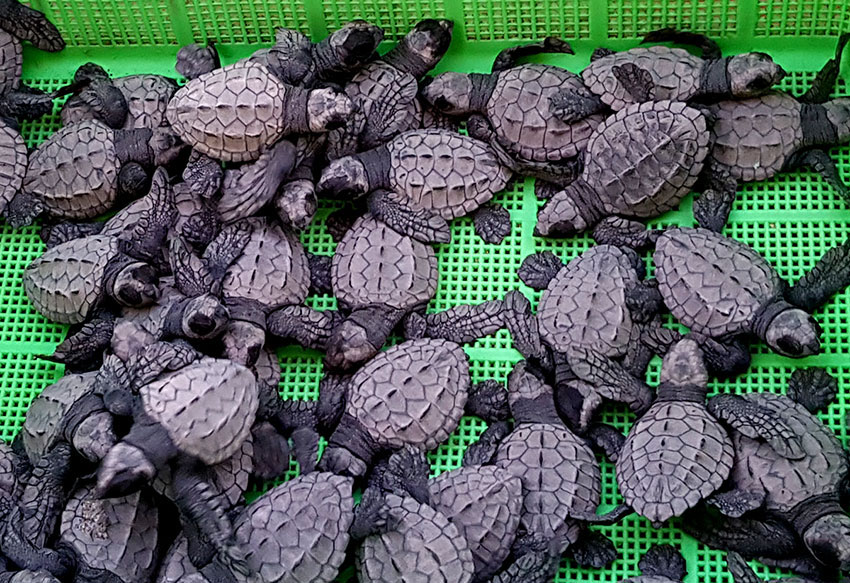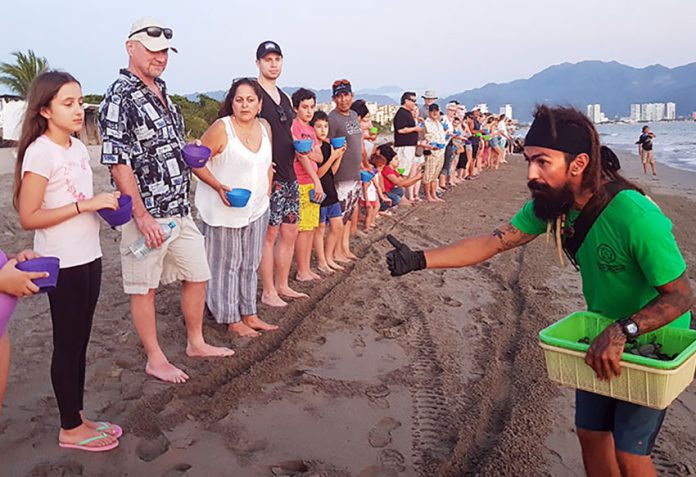The Río Ameca is 230 kilometers long and serves as the border between the Mexican states of Nayarít and Jalisco. It enters the Pacific Ocean at a place called Boca de Tomates, “The Mouth of the River, Where the Tomatillos Grow.” The tomatillo, by the way, is a green-purple member of the tomato family and important for making green salsa in Mexico.
Through the mouths of rivers, all sorts of organic materials flow into the ocean, including bits of debris like bark or branches to which a tiny baby sea turtle could attach itself to take advantage of a long, free ride, hopefully unnoticed by predators.
So it is that sea turtles discovered Boca de Tomates long before human beings did, turning it into such a popular spot for laying their eggs that tiny Boca de Tomates beach — only 2.5 kilometers long — is by far the year-round most popular spot on Mexico’s Pacific Coast for mama turtles to lay their eggs.
“All the nearby turtle-release programs are shut down right now,” volunteer Carlos Hernández told me, “but last night three mothers appeared on our beach to lay their eggs, and every evening people show up here to help us give baby turtles a safe run across the beach for their first plunge into the ocean.”
To better understand this turtle conservation program, I asked permission to spend a night at Campamento Boca de Tomates, which is located precisely at the very southwest tip of the Puerto Vallarta Airport.

That might sound like quite a busy place, but as my friends and I trudged through the loose sand, carrying our camping gear, it felt like we were marching into the middle of nowhere. “We have no electricity or running water,” said Carlitos, as everyone calls him, “but we do have crocodiles, because between us and the airport there’s a mangrove estuary.”
Once we had set up our tents and cooled off in the water, I asked Carlos to tell me a little about Campamento Boca de Tomates.
“This project,” he said, “was started 30 years ago by the University of Guadalajara. Around 2015 it became a member of Mexico’s Turtle Network (Red Tortuguera) and later of Grupo Tortuguero de las Californias.
“This facility of ours is now run by the municipality of Puerto Vallarta and it is, first of all, a school, dedicated to the protection and conservation of sea turtles. Here we receive groups of children from elementary, secondary and prep schools and we also go out to those schools to give courses for raising environmental awareness.
“We know that when these kids grow up, they will often visit the beach at night and we want to influence the sort of reaction they’re going to have when they discover turtles on the shore. For example, most people don’t realize that sea turtles — like many other creatures — rely on moonlight for orientation. So, if a mother turtle comes out of the water to lay her eggs and somebody starts taking flash photos, that mother will not only be frightened, but will also be totally disoriented. Perhaps she will go back into the water and later make another try, but if she gets frightened again, she’ll simply abort and release her eggs into the water where they’ll all die.
“We want to influence future generations of people who live here on the coast, so they won’t make that sort of mistake, or, to give another example, so they won’t throw a plastic bag into the water, because they will know that, to a turtle, the bag looks just like a medusa, one of the sea turtle’s favorite prey.”

Carlitos pointed out to me that sea turtles are keystone animals like otters and wolves. “If the turtle is not there to keep the medusa under control, the medusa proliferates like crazy and kills absolutely everything living on the coral reef. Another important thing that sea turtles do is to control the growth of seagrasses. If these proliferate, they consume all the oxygen in the water and everything dies.”
Another interesting thing that Carlitos mentioned is that all turtles started out as land animals 20 million years ago, “so sea turtles have to leave the ocean, make their nest on land and give birth on land — it’s their curse, you could say, because on land they find their worst predator: us!”
In nesting season (July to December), Carlitos and his companions patrol the beach at Boca de Tomates all night long, looking for signs that turtle eggs have been deposited. “When we see scrape marks indicating that a mother has dragged herself across the sand and laid her eggs, we look for the nest by poking the sand with a stick until we come to a really soft spot. Then we collect the eggs and take them to a fenced-in area where we recreate the nest: narrow at the top and wide at the bottom, and we note the date we found it along with the probable hatching date.”
I was surprised to learn that exiting the nest is the only group activity that sea turtles participate in during their entire lives. “They’re normally solitary animals,” says Carlitos, “but when the first eggs in the nest hatch, those babies don’t try to reach the surface. They just sit and wait until the rest of their siblings hatch and then the whole lot of them (as many as 100) simultaneously make their way upwards and out at the same time. We help the process by removing the few at the very bottom of the nest who didn’t manage to find their way out, and we make sure there are no predators around at the moment they cross the beach, heading for the water.”
This crossing of the sand, I learned, is a crucially important step in the life of a sea turtle. As it crawls along, it memorizes the sound that the waves make in that particular spot. It seems that that sound is just a little different every few meters, and it is this acoustic fingerprint that will tell it, many years later, that this is indeed the beach where it was hatched and this is the very spot where it first entered the ocean.
[soliloquy id="106003"]
Every evening of the year — except during the months of April and May — the volunteers at Campamento Tortuguero welcome visitors who would like to participate in a turtle release. Exactly 30 minutes before sunset (solar time, not “Mexican time”), a biologist gives a talk in both English and Spanish and the visitors then line up parallel to the shore, several meters from the water line, where each receives a baby olive ridley sea turtle. Just as the sun sets, all of these are released at once, a memorable moment for both visitors and turtles alike.
If you’d like to participate, check with a Puerto Vallarta hotel or ask Google Maps to take you to “Paseo Bocanegra Marina Vallarta,” near the airport. Drive all the way to the seashore, at the end of the road. Then park and walk northwest (right) along the beach 650 meters.
If you have questions, whether in English or Spanish, see their Facebook page “Saving Sea Turtles in Puerto Vallarta Campamento Tortuguero Boca de Tomates” or Whatsapp 322 263 0249. Due to Covid-19, public gatherings at the Campamento have been temporarily suspended.
The writer has lived near Guadalajara, Jalisco, for more than 30 years and is the author of A Guide to West Mexico’s Guachimontones and Surrounding Area and co-author of Outdoors in Western Mexico. More of his writing can be found on his website.
